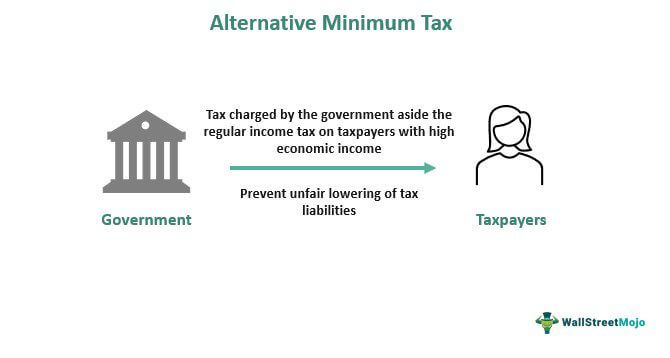Table Of Contents
What Is Alternative Minimum Tax?
The Alternative Minimum Tax (AMT) refers to a secondary tax applied to prevent taxpayers with high economic income from reducing their tax liability using tax benefits. The AMT provision can make wealthy people pay at least a minimum tax by reducing the chance of using tax benefits like tax deductions and credits to reduce their tax bill.

The taxpayer calculates regular income tax and AMT, then pays the larger amount. This way, AMT assures the extraction of minimum tax on the portion of a taxpayer's taxable income above a specific exemption. Its introduction aimed to ensure that those with greater earnings pay a minimum tax.
Key Takeaways
- Alternative Minimum Tax refers to tax applied in addition to the regular tax to prevent taxpayers with high economic income from reducing the tax payable below a fair amount.
- Its calculation involves computing alternative minimum taxable income (AMTI), subtracting AMT exemption from AMTI, and applying the tax rate of 26% or 28%.
- A taxpayer who has already paid the AMT on stock options in the current or previous years is qualified for the credit in a future year in which the AMT is not applicable.
Alternative Minimum Tax Explained
The alternative minimum taxable income is generally greater than the ordinary taxable income since alternative minimum taxable income is composed of additional items due to the addition of income and the disallowing of specific exemptions and deductions that are allowed under the regular taxation system. By preventing wealthy taxpayers from the act of avoiding their fair share of taxes, the system ensures that they atleast pay a minimum tax. Furthermore, the impact of AMT will be more intense if the taxpayer has used a high number of exemptions while calculating ordinary income tax.
A taxpayer has to use Form 6251 alternative minimum tax, to ascertain and determine the AMT liability. Taxpayers who obtain preferential treatment for their income or are eligible for certain deductions under the regular tax system are subject to the AMT. Some taxpayers with higher incomes may find that the tax incentives dramatically lower their normal taxes. The AMT limits the usage of tax benefits to lower overall tax.
Significant event from history includes U.S. Treasury Secretary Joseph W. Barr informing Congress in January 1969 that 155 taxpayers with incomes higher than $200,000 had not paid federal income tax in 1966. The story sparked outrage. Members of Congress received more letters from constituents about the taxpayers who have avoided paying taxes. Following that, Congress enacted an "add-on" minimum tax, which households had to pay in addition to their regular income tax. It applied to certain types of income that were not taxed under the regular income taxation system. The portion of capital gains exempt from regular income tax was the preferable item of the AMT system.
How To Calculate?
To calculate alternative minimum tax, the computation of alternative minimum taxable income (AMTI) is the significant and primary step. First, AMTI calculation takes the taxpayer's regular income and adds items like disallowed credits and deductions. Then subtracting the AMT exemption amount from AMTI occurs. Then the taxation of the resulting amount occurs at 26% or 28%, considering the income level. Finally, the taxpayers must pay the greater of the AMT or regular tax. This procedure essentially determines who pays the AMT and how much.
The IRS has established an alternative minimum tax rate of 26% on AMTI of $206,100 or less for non-corporate taxpayers for the tax year 2022. For married filing separate taxpayers, the income limit stops at $103,050. Above the cutoff, the tax rate increases to 28% of income. Multiplying the AMT rate with the difference between AMTI and the exemption results in the tentative minimum tax. In other words, AMT is the difference between an individual's ordinary income tax and the tentative minimum tax determined under AMT. Furthermore, the U.S. Congress passed a 15% corporate alternative minimum tax on applicable corporations in 2022.
What Is Alternative Minimum Tax Credit?
A taxpayer who has paid the AMT on stock options is entitled to a credit in a future year in which the AMT is not applicable. The AMT Minimum Tax Credit (MTC) enables the taxpayer to deduct a specific amount of earlier AMT payments against future income taxes higher than the AMT. In other words, when the taxpayer owes little or no AMT, they can use the credit to lower his regular tax.
Example
Let us look at an alternative minimum tax example to understand the concept better.
The AMT exemption amount for the tax year 2022 is $75,900 and begins to phase out at $539,900. This is applied in the calculation example shown below:

The AMT tax burden of $27,066 exceeds the ordinary tax burden of $12,997. The taxpayer pays a total of $27,066 in federal taxes. The $12,997 accounts to ordinary tax and $14,069 to AMT.

